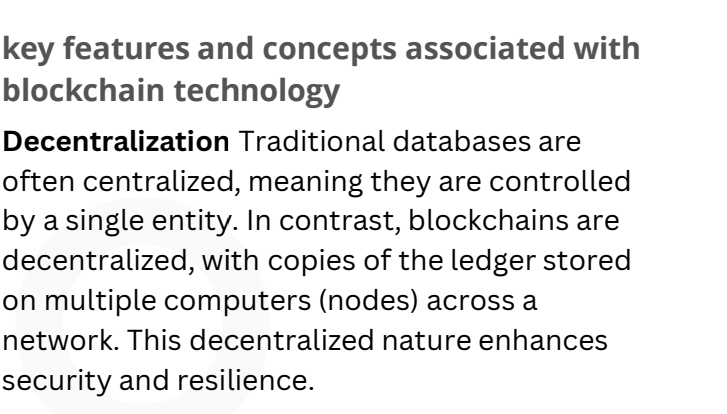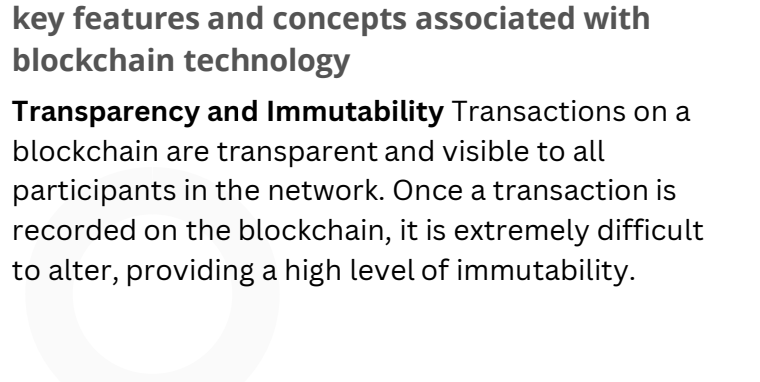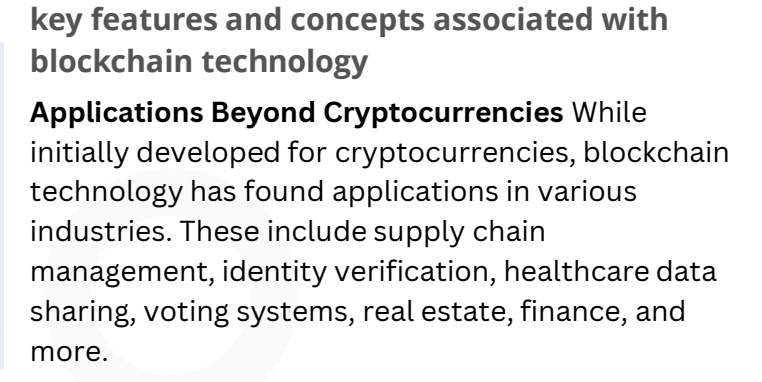LIVING-IN-THE-IT-ERA
1/95
There's no tags or description
Looks like no tags are added yet.
Name | Mastery | Learn | Test | Matching | Spaced |
|---|
No study sessions yet.
96 Terms
Data Mining
process of discovering patterns, trends, correlations, and useful insights from large sets of data
Science in Information Technology
Refers to the systematic study
and application of principles,
theories, and methodologies from
various scientific disciplines to
understand, develop and improve
the technologies and systems that
constitute the IT field
the interaction between humans and
computers.
Cryptography
It involves designing algorithms
and protocols to ensure the
confidentiality, integrity, and
authenticity of digital data
transmission, network protocols,
and the architecture of computer
networks. It enables the seamless
communication and sharing of
information between devices and
systems
software and applications to be
localized and translated to meet
the linguistic and cultural needs
of different regions
access to technology due to
economic, educational, or cultural
barriers. Bridging this divide
requires understanding and
addressing these cultural factors
prioritize privacy more than
others, leading to differences in
data-sharing behaviors and the
need for tailored privacy settings
stored, and used raises concerns
about user consent and control
over their information
systems to protect against
breaches, hacking, and data theft
is a vital ethical consideration
significantly alter or revolutionize
an industry or market by
displacing existing products,
services, or business models.
follow a specific pattern of
adoption and market
transformation.
features that appeal to a niche
market segment.
and gradually gains mainstream
acceptance. It starts to invade the
territory of existing solutions,
causing established player to take notice
advanced and its advantages
become clearer, it can disrupt
entire industries.
disrupted the traditional film-based
photography industry
automotive industry by replacing internal
combustion engine vehicles
Block Chain and Cryptocurrency
• Has disrupted various industries,
particularly finance, by enabling secure,
transparent, and decentralized transactions
• Its Likes disrupted various industries, particularly finance, by enabling secure, transparent, and decentralized transactions
Regulation and Ethics
The introduction of new
technologies often goes beyond
their technical capabilities. It
requires a broader consideration
of how these technologies fit into
society, how they impact
individuals and communities, and
how they align with societal
values
Resistance to Change
Established players might resist
adopting new technologies due to
investments in existing
infrastructure and processes
of disruptive technology can be
challenging, as factors like
consumer adoption
unauthorized access to personal data,
and surveillance issues have raised
questions about individuals’ control
over their digital identities.
attacks, and ransomware can
compromise sensitive information,
disrupt services, and cause financial
losse
lead to anxiety, depression, and reduced
face-to-face social interactions.
becomes challenging to distinguish
credible sources from unreliable ones,
undermining informed decision-making.
Loss in Human Communication
Overreliance on digital communication can weaken interpersonal relationships and social skills.
distress, mental health issues, and
sometimes even tragic outcomes.
Dependecy on Technology
Society’s increasing reliance on
technology can create vulnerabilities. If
systems fail or are compromised,
essential services and infrastructure
might be disrupted, impacting various
aspects of li
Erosion of Privacy
The constant connectivity enabled by
ICT can erode personal privacy.
Surveillance technologies, data collection
practices, and the sharing of personal
information can create a sense of being
constantly monitored
4th Industrial Revolution
often referred to as Industry 4.0, represents a new phase of technological advancement that builds upon the third industrial revolution (the digital revolution) and blurs the lines between the physical, digital, and biological spheres.
Internet of Things
involves connecting everyday objects to the internet and enabling them to send and receive data.
Conmected Devices
involves connecting everyday objects to the internet, turning them into SMART DEVICES. These can include anything from thermostats and refrigerators to vehicles and wearable fitness trackers
Data Collection and Analysis
IoT devices generate a vast amount of data through sensors and interactions.
Smart Cities
Traffic management, waste management, energy distribution, and public safety can all benefit from interconnected devices and data analysis.
Supply Chain Management
IoT devices can track the movement of goods along the supply chain, enhancing transparency, traceability, and reducing delays.
Security and Privacy
While IoT offers numerous benefits, it also raises concerns about data security and privacy. As more devices collect and transmit data, ensuring robust security measures is essential to protect sensitive information.
Big Data Analysis
The 4th Industrial Revolution generates an unprecedented amount of data. IT systems are crucial for managing and analyzing this data to extract meaningful insights. This is essential for making informed business decisions, improving products and services, and optimizing processes
Artificial Intelligence and Machine Learning
Technologies that are central to the 4th Industrial Revolution. These systems can process and analyze large datasets, automate complex tasks, and even make autonomous decisions
Cybersecurity
measures to protect sensitive data, critical infrastructure, and personal information from cyberattack
Firewalls
Hardware or software-based systems that monitor and control incoming and outgoing network traffic to prevent unauthorized access.
Antivirus and Antimalware
It's important to note that the threat landscape is constantly evolving, and new forms of malware are developed regularly. As a result, keeping your _____ and ____ software up to date is crucial to ensure that you are protected against the latest threats
Multi-Factor Authentication
Requiring users to provide multiple forms of verification to access systems, enhancing security
IoT and Industrial Control Systems Security
Protecting these interconnected systems presents unique challenges due to their widespread use.
Edge Computing
is a distributed computing paradigm that involves processing data closer to its source rather than sending it to a centralized cloud server for processing. In traditional cloud computing, data is sent to remote data centers for processing and analysis.
Robotics and Automation
The 4th Industrial Revolution sees an increase in the use of robotics and automation in various industries. IT professionals are responsible for rpogramming and managing these robotic ysstems, as well as integrating them with other IT systems.
Digital Twins
is a virtual representation of a physical object, process, or system. It enabling organizations to simulate and optimize real-world scenarios before implementation.
Augmented Reality (AR) and Virtual Reality
IT is responsible for creating and supporting the infrastructure needed for these immersive experiences.
Blockchain Technology
____ provides secure and transparent transaction records. In the context of Industry 4.0, it can be used for supply chain management, digital identity verification, and more. IT professionals work on implementing and maintaining blockchain systems.




Access Divide
This aspect of the digital divide refers to the disparity in the physical access to digital technologies and the internet. Some people may lack the necessary infrastructure, like broadband internet or computers, to get online.
Usage Divide
Some individuals may not possess the digital skills or knowledge required to effectively use the internet and digital tools or various purposes, such as education, job searches, or healthcare.
Digital Divide
refers to the gap or disparity in access to and use of digital technologies and the internet between different groups or communities, often based on factors such as socioeconomic status, geography, age, education, and more.
Affordability Divide
The cost of digital devices, internet service, and software can be a barrier for many people, particularly those with limited financial resources. High prices for devices and data plans can restrict access for lower-income individuals and families
Relevance Divide
Some individuals and communities may not see the relevance of digital technologies to their lives or may lack awareness of the potential benefits. This can lead to underutilization of available resources.
Empowerment Divide
This divide relates to the ability of individuals and communities to leverage digital technologies for personal and collective empowerment. Those who can effectively use digital tools are often better equipped to access information, participate in online communities, engage in civic activities, and pursue economic opportunities.
Geographic Divide
Rural areas may face unique challenges in terms of digital infrastructure development, with limited access to high-speed internet and mobile networks.
Infrastructure Access
This dimension refers to physical access to digital infrastructure, including broadband internet, computers, smartphones, and other digital devices.
Connectivity Access
Access to reliable and high-speed internet is a crucial component of digital access. Disparities in connectivity can result from differences in the availability of broadband services, mobile network coverage, and the affordability of internet plans.
Digital Skills
Digital literacy and skills play a significant role in the effective use of digital technologies. Disparities in digital skills can stem from differences in education levels, age, and exposure to technology.
Online Services and Application
Differences in the use of online services and applications, such as e-commerce, online education, telemedicine, and government services, can contribute to the digital divide. Some individuals may lack access to or knowledge about these services.
Cost of Devices
The affordability of digital devices, including computers, smartphones, and tablets, can be a significant barrier to access. Low-income individuals and families may struggle to purchase the necessary hardware.
Cost of Internect Service
It includes monthly subscription fees, can be a barrier to access for many people, especially in regions with limited competition among internet service providers.
Perceived Relevance
Some individuals and communities may not perceive the internet and digital technologies as relevant to their daily lives, which can lead to a lack of interest in adopting these technologies.
Content and Language Barriers
Limited availability of content in local languages and culturally relevant digital resources can deter individuals from engaging with digital technologies.
Income and Wealth
Socioeconomic status can be a major determinant of digital access. Low-income individuals and families may struggle to afford both devices and internet services.
Education
It can influence digital skills and literacy, as those with higher education often have more exposure to technology and digital resources.
Infrastructure Investment
Governments and private sector entities can invest in building and expanding digital infrastructure, including broadband networks, especially in underserved rural and remote areas. This involves laying down the necessary physical infrastructure to ensure internet access for all.
Affordable Access
To make digital technologies more accessible, policymakers can work to reduce the cost of internet service and digital devices. This may include subsidies for low-income individuals or families, encouraging competition among internet service providers, and promoting the development of affordable digital devices.
Digital Literacy Programs
Educational institutions and organizations can offer digital literacy programs and training to individuals who lack digital skills. These programs teach people how to use digital tools effectively, access online information, and protect themselves online.
Community Access Centers
Establishing community centers with free or low-cost internet access and digital resources can help bridge the gap for individuals who lack access at home. These centers can provide a safe and supportive environment for people to learn and use digital technologies.
Digital Inclusion Initiatives
Governments, nonprofits, and businesses can launch digital inclusion initiatives aimed at marginalized or disadvantaged communities. These initiatives may include providing free or discounted devices, internet connectivity, and digital skills training.
Public-Private Partnerships
Collaboration between government entities and private sector companies can be instrumental in expanding digital access. Public-private partnerships can help fund infrastructure projects and initiatives to make digital technologies more accessible.
Data Privacy and Security Education
Alongside digital literacy, individuals should also be educated about online privacy and security to protect themselves from cyber threats.
Inclusive Design
When developing digital products and services, businesses and organizations should consider inclusive design principles to ensure that their offerings are accessible to people with disabilities and diverse backgrounds.
Research and Assessment
Continuous research and assessment of the digital divide's impact and its changing dynamics are essential for designing effective strategies and measuring progress.